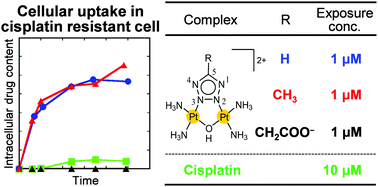Highly efficient uptake into cisplatin-resistant cells and the isomerization upon coordinative DNA binding of anticancer tetrazolato-bridged dinuclear platinum(ii) complexes†
Abstract
We examined the cytotoxicity and cellular uptake in L1210 murine leukemia cells, as well as the coordinative reaction with the guanine derivative 9-ethylguanine (9EtG), of a series of μ-hydroxo-μ-tetrazolato dinuclear platinum(II) complexes (tetrazolato-bridged complexes), [{cis-Pt(NH3)2}2(μ-OH)(μ-tetrazolato-N1,N2)]2+ (5-H-X) and [{cis-Pt(NH3)2}2(μ-OH)(μ-5-R-tetrazolato-N2,N3)]n+, where R = H (5-H-Y), CH3 (1), C6H5 (2), CH2COOCH2CH3 (3), or CH2COO− (4), and n = 2 (5-H-Y, 1–3) or 1 (4). Most tetrazolato-bridged complexes overcame cross-resistance to cisplatin and were more efficiently taken up into cisplatin-resistant cells (L1210R) than into parental cisplatin-sensitive cells (L1210), whereas cisplatin uptake into L1210R was decreased compared with that into L1210. The cellular uptake was most likely controlled by the total charge of the complexes. There was no correlation between the cytotoxicity and the kinetics of the coordinative reactions of 1–4 with 9EtG, but the isomerization involved in the reactions could contribute to determining the higher order structures of the compacted DNA. The cytotoxicity of tetrazolato-bridged complexes appears to correlate with the efficiency of cellular uptake and DNA compaction.


 Please wait while we load your content...
Please wait while we load your content...